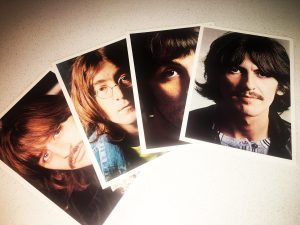In November 1968, The Beatles released “The Beatles” AKA, The White Album, as a double-album follow-up[1]The Beatles released Magical Mystery Tour a few months after Sgt Pepper’s in 1967 (a double EP in the UK & an LP in the USA) as the soundtrack for a film of the same name, that also … Continue reading to their landmark LP, Sgt Pepper’s Lonely Hearts Band. Still suffering from the loss of Brian Epstein, and a growing distance from long time producer & creative partner George Martin (who had by then left Parlaphone/EMI and was operating as an independent producer while helming the newly created AIR[2]Associated Independent Recording – initially offering independent production and recording for hire), the marathon recording sessions for the The White Album were both arduous and difficult, but there’s no denying that they produced some of the most varied, dynamic, and interesting songs of their entire catalogue.

The Abandoned Maharishi Mahesh Yogi Ashram – Rishikesh, India by Thoralf Guiterrez
A majority of the songs recorded for The White Album were written during the Beatles’ famed Indian Meditation retreat at Rishikesh, where (reportedly), free from drugs, and in the clarity of the pastoral setting under the shadow of the Himalayas, John & Paul (& George)[3]And – it would be fair to say, Ringo too, whose first recorded solo writing credit appears on The White Album with “Don’t Pass Me By”. Although it appears that Starr finalized … Continue readingfound themselves incredibly & prolifically inspired. These, and other songs, would later be rehearsed and arranged at George Harrison’s Esher home upon their return to the UK just prior to assuming their 4 month residency at Abby Road Studios to record the album. The four sides of The Beatles collectively hold 30 songs, and it would not be an exaggeration to call it an eclectic or even eccentric mishmash of songs styles and pastiches. With the inclusion of the avant garde Revolution 9, it has the distinction of featuring one of their most controversial and perhaps most hated recordings of their whole catalogue. But where some have found The White Album overly long, pompous, and disjointed, others have found it to be a work of genius, greatness, and even the sublime. And this month, with the release of the 50th anniversary edition, those debates have been given new life with the inclusion of studio out-takes and bonus tracks (including the fabled Esher demos), as well as fresh new stereo mixes & mastering.
As a collection of songs, The White Album doesn’t have an obvious thematic centre or narrative, and some listeners have struggled to navigate its waters, finding the diversity a distraction. Others have argued that this is precisely what gives the album its cohesion – that it is a collection of songs and pastiches from 4 artists struggling with the very idea of identity. And under the intense camera eye of the world, unlike any before them in history, this struggle and these tensions helped produce some of the most vital and authentic songs of their careers. With Sgt. Pepper’s, The Beatles embodied a fictional personae, sheltering behind the guise of their creation, and produced one of the finest albums in the history of the medium in the process. With The White Album, gone were the costumes and the faux conceit, and in their stead were pastiches, and songs with layers of complexity in both structure and content; each functioning as transitory moments of identity materializing within the song. Some songs were singular; singular works by a singular member – standing alone and apart from the others, while some were cooperative, and incredibly self referential and meta. And yet through them all there exists connective tissues that formulate as you listen, and make the act of listening to the albums an act of creation in and of itself.
If this sounds like a burden it shouldn’t be. It will happen unconsciously in the mind (if you let it). Our brains are creative organs – they function to “make sense” and orientate within the chaos and noise of existence. It’s literally what they do. But if that still sounds like too much burden, start with something simple: follow the Indian songs (in red), or follow John*, or Paul#, or George!, or start with Ringo& and see just what happens next – as long as you don’t pass him by[4]I couldn’t resist – sorry! he’ll be happy to be included. You can also take pathways through the rockers, or the ballads, or the obvious pastiches and homages to style and form. You can follow the experimental, or the stories, or make your way through the personal, or the silly — or the profane. But above all – don’t give up – because there are many trips and journeys to take through The White Album; many different playlists and iterations to construct and deconstruct on repeated listens.
 My relationship with the Beatles’ catalogue is lifelong. I started very young (around 6 years old) and have listened to them my whole life. I come and go; making and remaking my acquaintance with different songs and albums through different time periods and stages in my life. And the journey always rewards. It always yields itself to me with new discoveries. I didn’t get my first copy of The White Album until the 1988 CD boxed set was released. I didn’t get another copy until the 2008 mono boxed set. The mono boxed set I described as “a revelation” when I first heard it. Now with the release of the 50th Anniversary Edition we have new mixes/masters, as well as the Esher demos and many different alternative takes and unreleased goodies that I’m just swimming in the new. It’s a re-visitation that has re-inspired me to put The White Album at the top of my playlist. And for the first time in a very long time I had the patience to sit through the whole album in it’s original running order without skipping a song; not even Revolution 9. And I have to say, each and every song felt right to me just where it was. It all seemed to make perfect sense. For me that’s the magic of The White Album right there, and I love it!
My relationship with the Beatles’ catalogue is lifelong. I started very young (around 6 years old) and have listened to them my whole life. I come and go; making and remaking my acquaintance with different songs and albums through different time periods and stages in my life. And the journey always rewards. It always yields itself to me with new discoveries. I didn’t get my first copy of The White Album until the 1988 CD boxed set was released. I didn’t get another copy until the 2008 mono boxed set. The mono boxed set I described as “a revelation” when I first heard it. Now with the release of the 50th Anniversary Edition we have new mixes/masters, as well as the Esher demos and many different alternative takes and unreleased goodies that I’m just swimming in the new. It’s a re-visitation that has re-inspired me to put The White Album at the top of my playlist. And for the first time in a very long time I had the patience to sit through the whole album in it’s original running order without skipping a song; not even Revolution 9. And I have to say, each and every song felt right to me just where it was. It all seemed to make perfect sense. For me that’s the magic of The White Album right there, and I love it!
- LP1-SIDE A /CD1: The BEATLES (‘White Album’) 2018 Stereo Mix
1. Back in the U.S.S.R. #
2. Dear Prudence *
3. Glass Onion *
4. Ob-La-Di, Ob-La-Da #
5. Wild Honey Pie #
6. The Continuing Story of Bungalow Bill *
7. While My Guitar Gently Weeps !
8. Happiness is a Warm Gun *
LP1-SIDE B/ CD1: The BEATLES (‘White Album’) 2018 Stereo Mix
9. Martha My Dear #
10. I’m so tired *
11. Blackbird #
12. Piggies !
13. Rocky Raccoon #
14. Don’t Pass Me By &
15. Why don’t we do it in the road? #
16. I Will #
17. Julia *
- LP2-SIDE C/CD 2: The BEATLES (‘White Album’) 2018 Stereo Mix
18. Birthday #
19. Yer Blues *
20. Mother Nature’s Son #
21. Everybody’s Got Something to Hide Except Me and My Monkey *
22. Sexy Sadie *
23. Helter Skelter #
24. Long, Long, Long !
LP2_SIDE D/CD 2: The BEATLES (‘White Album’) 2018 Stereo Mix
25. Revolution I *
26. Honey Pie #
27. Savoy Truffle !
28. Cry Baby Cry *
29. Revolution 9 *
30. Good Night *
Feature Photo Credit: The Beatles (White Album) 2009 remaster contents by Rudy Riet, via flickr (CC BY-SA 2.0)
Additional photos: Untitled by Thoralf Guiterrez via flickr, (CC BY=NC 2.0)
Notes & References
| ↑1 | The Beatles released Magical Mystery Tour a few months after Sgt Pepper’s in 1967 (a double EP in the UK & an LP in the USA) as the soundtrack for a film of the same name, that also included a compilation of the 1967 singles. It wasn’t recorded as a successor to Sgt Pepper in so much as it was a parallel project |
|---|---|
| ↑2 | Associated Independent Recording – initially offering independent production and recording for hire |
| ↑3 | And – it would be fair to say, Ringo too, whose first recorded solo writing credit appears on The White Album with “Don’t Pass Me By”. Although it appears that Starr finalized or “completed” the song in India, it has been noted that it had been kicking it around in bits and pieces for years. |
| ↑4 | I couldn’t resist – sorry! |


